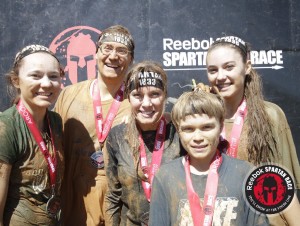 A few weeks ago I experienced my first Spartan Sprint.
A few weeks ago I experienced my first Spartan Sprint.
The “Sprint” is a 4-5 mile obstacle course race created by Joe De Sena, an entrepreneur and extreme endurance race enthusiast.
In 2012, Outside magazine designated it the “Best Obstacle Race,” and hundreds of thousands of people have participated in Spartan race events around the world.
I figured it would be a fun experience for my family and I to share.
So on the Saturday morning of the race, my wife and I, along with our three children (ages 16, 14, and 11) hopped in our SUV and made our way to the race site, prepared with a change of clothes and several towels.
We had seen pictures of mud-covered participants and had an idea what to expect, but the idea of something – and the experience itself – are truly two very different things.
We arrived at the registration tent and got our bib envelopes – and it was my wife who noticed the red, bolded message that stated “There is a real possibility YOU MAY DIE …”
Hundreds of participants gathered at the starting line every fifteen minutes to be sent out onto the course. Eventually our Spartan Race time arrived, and we stood in a large group, nodded and shared a “good morning” or apprehensive comment with those around us, and when the horn went off we started to run.
The course weaved through woods and hills and lots of Georgia red clay, while providing nearly 20 obstacles to navigate along the way.
There were walls to climb that ranged from 5-8 feet high.
There were rock-filled buckets and sandbags to carry a few hundred yards.
There were several mud hills to climb over and chilly water filled holes to wade through.
There were ropes to climb and ropes with 100 lbs. of sand to pull
There were over 50 yards of ground where you had to crawl under barbed wire
And through it all, there were a handful of valuable leadership and teamwork lessons that I took away with me, along with the obligatory mud and scratches and physical exhaustion.
1- Compete less and encourage more: It was tremendous to hear the people around us who, instead of focusing only on themselves, were constantly aware of others and their struggles. Participants shared encouragements along the way, and helped their peers to overcome each of the challenges. “Not far now!” and “You can do it” can be powerful motivators, whether on a race course or in an office.
2- Everyone moves at a different pace: It’s important for people to run their own race and not try to keep up with or compare their performance with others. My son and youngest daughter ran ahead of us – and finished 20 minutes before my wife and oldest daughter and I did. Your people will learn and develop and grow at different speeds as well.
3- Keep your head up: Stay positive and look where you are going. The paths through the woods were very narrow and had roots, rocks and tree limbs that could be dangerous if you were not focused on where your next step should be. Great leaders see and communicate possible obstacles and where next steps should be.
4- Refresh yourself along the way: There were water stations every mile or two where volunteers offered water to the participants, but not everyone grabbed the cups. Later in the race, you saw many of those people cramping or off to the side, camped out at the next water station and drinking to try and make up for their dehydration. The same thing happens on teams that do not celebrate along the way – recognition is the refreshing fuel that keeps your people going through difficult times.
5- Everybody needs (and is willing to) help: Asking for help is not a sign of weakness, it is evidence of knowledge and personal strength. My wife needed a hand to get over the wall’s and my daughter needed assistance with the rope pull – and I needed help when I started to slide down a mud hill and couldn’t get a foothold… but people were always reaching out when they sensed you needed a hand. The key is to reach out.
6- Just keep moving – the hills have two sides: if you are running uphill, there is always a downhill experience not too far away. Downhill runs are easy because you have gravity your side – but you only get to enjoy the downhill momentum if you have worked to get uphill first. If the going gets tough, keep going – and soon you will get tough! Seek progress, not perfection. Muddy and tired and walking is better than muddy and tired and sitting, and far superior to clean and spectating. Just put one foot in front of the other, and you will stay ahead of those who are frozen by fear or fatigue.
7- You really are tougher than you think: At the first obstacle, my wife was unsure that she would be able to get over the wall, and truly doubted her ability to finish the race – but she learned, like others do, that you can overcome more than you think when you are determined to succeed and go for it.
8- Real training takes more than a day or two: The old saying that “you can’t train in one night for the Olympics” is true, and I had to walk some parts of the race because I hadn’t trained well. Once you know what is needed to succeed in your field, you have to invest time in consistently doing what’s important. Just like getting in shape takes more than one race, team building events can be a great catalyst for deeper conversations, but to transform your organization’s culture leaders need to maintain that focus on building better connections and relationships.
9- Wear your scars with pride: At the end of the day, whether it is on an obstacle course or anywhere else, if you are truly pushing yourself to do something difficult you will sometimes get scrapes and cuts and bruises. Scars are not signs of weakness, they are trophies of experience. Your past provides an opportunity for wisdom – but only if you learn from those experiences. The best leaders and teammates realize that only the people who are in the arena get to earn them and benefit from their lessons.

I was surprised by how dirty and brown I was at the finish line, by how cold the wet clothes I was wearing felt, and by how much my legs and chest burned from the over two hours it took us all to finish.
But I was also surprised by how proud our family smiles were when they took our photo.
And the lessons that I and my children will take away from that experience, the feelings of accomplishment and toughness and helpfulness, will more than make up for the scrapes and the few days of soreness that followed.
Great leaders know that you should never tell your people it is going to be easy – instead, you tell them it is going to be WORTH IT.
Whatever challenge your team is experiencing now, just remember to encourage each other, keep moving, keep your head up, stay refreshed, and be assured that someday soon the scars you are collecting will benefit you and your cause.
If you are looking for an energizing motivational teamwork keynote, Sean can deliver a message that is customized to your audience.
You can also follow Sean on twitter or to connect with Sean on LinkedIn for additional information, quotes, and teamwork resources…

